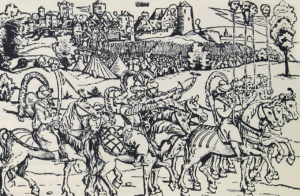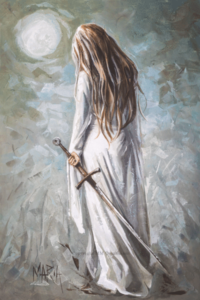A scene from the last days of Kőszeg’s siege in 1532:

Imagine: the defenders, led by Nikola Jurišić (Jurisics Miklós) at the beginning of the siege, had only 46 soldiers and 700 armed peasants, not counting the German citizens and the 1,800 women and 2,300 children/adolescents, facing Sultan Suleiman’s army of at least 80,000 men. After repelling 18 full-scale attacks between 5 August and 27 August, the Turks launched their final assault on the surviving Hungarian, German and Croatian defenders. We are sure that many women and young people joined the fighting men, as they had done at the siege of Eger Castle in 1552 and elsewhere. Armed Hungarian women on the ramparts were not an uncommon sight for the Ottoman invaders of the Borderland.

There are two legends about beating back this last assault. According to Paolo Giovio (Iovious), the Turks saw St. Marton with a fiery sword in his hand riding from the sky and he frightened the victorious Ottomans. He wrote: “The Turks said that they heard the cries of the guards, who rushed out of the castle unharmed and saw a horseman in the air with his sword drawn, threatening them (the Turks) as they charged. It was undoubtedly the figure of Saint Martin…” Paulus Iovius said he had heard this story in Vienna, right after the siege.

Another chronicler, Istvánffy Miklós also mentioned it: “It is said that a horseman of great stature and stately appearance seemed to burst out of the castle with shining weapons, bringing with him many soldiers to the aid of the struggling townspeople. This caused such unusual fear and terror among the Turks that they retreated headlong from the walls. Five of the townspeople saw it the same way and declared that their patron saint, St Martin, had appeared at the right moment to bring help to the besieged and restore their own courage”.

On the other hand, a historian called Bariska István says that Captain Jurisics wrote to Ferdinand on 30 August 1532 that when the Turks got into the castle, “they heard the wailing of our women and children and from this, they thought that we had hidden armed soldiers into the houses so they got frightened”.

The Turks had been charging the walls since dawn, pushing back the defenders and even wounding Captain Jurisics. All was hopeless, the enemy was already inside the castle. Legend has it that at 5 o’clock in the morning, the people of Kőszeg held a mass in the church of St. Jakab. They wanted to prepare themselves for certain death and at the same time witness the wedding of Markó Bálint and his bride Margit. The bride wore her best dress, and the people also put on their best clothes. Meanwhile, the defenders could not stop the Turks and were pushed back to the wall of the church.

Seeing this, Markó Bálint took his sword and joined the soldiers, but his bride followed him with her sword drawn. The people poured out of the church and rushed to the aid of the screaming bride, who attacked the enemy like an avenging angel. Margit was determined to defend her love and slaughtered the enemy. At her heels, the people were so loud that the enemy was frightened by this unexpected sight and fled, turning their backs. What a surreal scene.

Later, the shocked Janissaries told their officers that they were incapable of fighting against heavenly creatures who took the form of men. The siege was lifted and Suleiman’s army returned home. However, to save face, the Ottomans were allowed to plant their flag on the ruins of the small castle that, against all odds, was blocking their way to Vienna. Even without the miracle of St Martin or Lady Margit, this would have been a remarkable deed. Since then, the people of Kőszeg ring their bells every day at 11 a.m. to commemorate the time when the Turks left for home.
Margit and Bálint indeed got married on that day. We know that Markó Bálint was one of the 12 members of the town council who helped Captain Jurisich during the siege. He was a very rich citizen of the town, he lived in such houses of Kőszeg:

There is a very sad story connected with this event. In 1539, Margit (she was probably also German) cursed a German citizen, telling him that he would end up like a speared frog. The problem was that her curse was taken seriously. She was accused of witchcraft, arrested, tortured, and forced to admit that she was a witch, or at least that she used magic. Finally, she was pardoned and her punishment was “suspended”. We have all the documents written by her persecutors. We also know that her daughter was the wife of Forintos Mátyás, the artilleryman of Jurisich. It is said that poor Fotintos was also accused of witchcraft when he was 81 years old in 1561. Unfortunately, these witchcraft cases were actually caused by power struggles between the richest German citizens of Kőszeg.

However, the white dress worn by the bride in 1532 must be a later addition to the story. Wearing white on a wedding day was not considered lucky in those days, so Margit must have worn her best dress for the occasion, which took place on the most dangerous day of the siege. The whole story may even be true, although the torturer didn’t mention it in his report in 1539.

As to whether German citizens (and their wives) could use the sword, we have facts. We know that longsword fencing was a very popular sport among the German burghers, and we know of several fencing guilds where they could learn to use the sword.
You can read more about Kőszeg castle and its siege on my page: https://www.hungarianottomanwars.com/kingdom-of-hungary/koszeg/

Dear Readers, I can only make this content available through small donations or by selling my books or T-shirts.
If you like my writings, please feel free to support me with a coffee here:
You can check out my books on Amazon or Draft2Digital, they are available in hardcover, paperback, or ebook:
https://www.amazon.com/dp/198020490X
or at https://books2read.com/b/boYd81


My work can also be followed and supported on Patreon: Become a Patron!http://Become a Patron!


https://hungarianottomanwars.myspreadshop.com/all
[wpedon id=”9140″ align=”center”]


